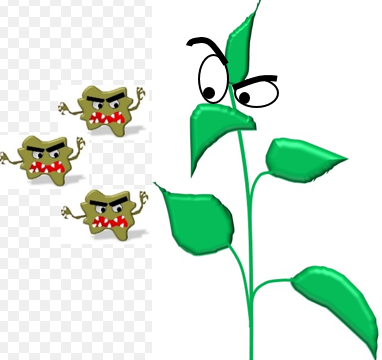Plant Resistance to insects
Definition: Resistance of plants is the property that enables a plant to avoid, tolerate or recover from injury by insect populations that cause greater damage to other plants of the same species, similar environmental conditions. This property generally derives from certain biochemical and morphological characteristics of plants which affects the behaviour and/or the metabolism of insect as to influence the relative degree of damage caused by these insects.
Historical development
I. Insect-Plant interactions
A. Evolution of Insect-Plant Interactions
B. Behavioral and Physiological Components of Insect-Plant Interactions
1. Host-Habitat Findings.
2. Host Findings
3. Host Recognition
4. Host Acceptance
5. Host Suitability
C. Plant Components in the Interactive System
1. Physical Factors
2. Chemical Factors
D. The Relationships of Plant Stimuli and Insect Responses
II. Host-Plant Selection and Mechanisms of Resistance
A. Ecological Resistance
1. Phenological Asynchrony/Pseudoresistance
2. Induced Resistance
B. Genetic Resistance
1. Resistance Factors Influencing Behavioral Process/Antixenosis
2. Resistance Factors Influencing Metabolic Process/Antibiosis
3. Phonetic Resistance
4. Tolerance
III. Genetic basis of Resistance
A. Oligogenic Resistance/Vertical resistance (qualitative or biotype specific)
B. Polygenic: Resistance/Horizontal resistance/non-specific resistance/ general resistance/quantitative resistance
C. Cytoplasmic Resistance
Mechanism of Resistance
Genetic Resistance
Antixenosis
Antibiosis
Tolerance
Ecological Resistance
Pseudoresistance
Induced resistance
Plant Defense Mechanisms
Antixenosis
Antibiosis
Tolerance
Ecological resistance
Host plant resistance: The relative genetic ability of a cultivar to produce a larger or higher quality crop compared with other cultivars exposed to the same infestation level.
Resistant variety:A variety which produces a larger amount of a good quality crop than other varieties when grown under the same conditions and exposed to similar populations of insect or diseases.
Sources of resistance: Varieties or breeding lines that have genes for insect resistance.
Mechanism of resistance: Processes involved in the resistance of a plant to an insect, including non-preference, antibiosis, and tolerance as proposed by Painter.
a) Non preference (Antixenosis):When a plant possesses characteristics that make it unattractive to insect pests for oviposition, feeding or shelter.
(b) Antibiosis:When the host plant adversely affects the bionomics of the insects feeding on it.
(c) Tolerance:Ability of a plant to withstand infestation and to support insect populations that would severely damage susceptible plants.
(d) Phonetic resistance: Resistance mechanism related to morphological or structural plant features that impair normal feeding or ovipositing by insects, or contribute to the action of other mortality factors.
Monogenic resistance:Resistance governed by one gene. Major gene resistance.
Oligogenic resistance:Resistance governed by a few genes. Major gene resistance.
Polygenic resistance:Resistance governed by many genes. Minor gene resistance.
Cytoplasmic resistance: Cytoplasmic inheritance is due to self-duplicating, mutable substances found only in the cytoplasm. Because the ovum contributes most of the cytoplasm to the zygote, cytoplasmic inheritance is material. This type of inheritance is commonly analyzed by determining the contributions made by each parent in reciprocal crosses.
Ecological resistance:The environment may favor the plant or insect unequally, or may alleviate or aggravate damage. The resulting type of resistance is ecological resistance It is broadly categorized as pseudoresistance and induced resistance.
Pseudoresistance:Apparent resistance which results from transitory characters in potentially susceptible host plants. Types of pseudoresistance are host evasion, induced resistance, and escape.
Induced resistance:A type of pseudoresistance in which a plant temporarily acquires increased resistance from some conditions of plant environment, such as change in soil fertility.
Horizontal resistance (General resistance): A type of resistance expressed equally against all biotypes of a pest species. It does not involve a gene-for-gene relationship.
Vertical resistance:A type of resistance which is expressed against only sonic biotypes of a pest species and is governed by one or more gene in the host plant, each of which corresponds to a matching gene for parasitic ability in the pest species; sometimes called gene-for-gene resistance.
Moderate resistance:Intermediate levels of resistance, between highly resistant and susceptible.
Multiple resistance:Resistance to several stresses such as insects, nematodes, diseases, drought, and nutritional deficiencies.
Seedling resistance:The characteristically vertical resistance of plants in the seedling stage.
Virulent gene: A gene in an insect which is able to break down the gene for insect resistance in the plant and thus allows the insect to use the plant as a host.
